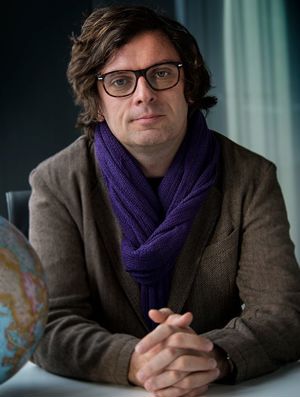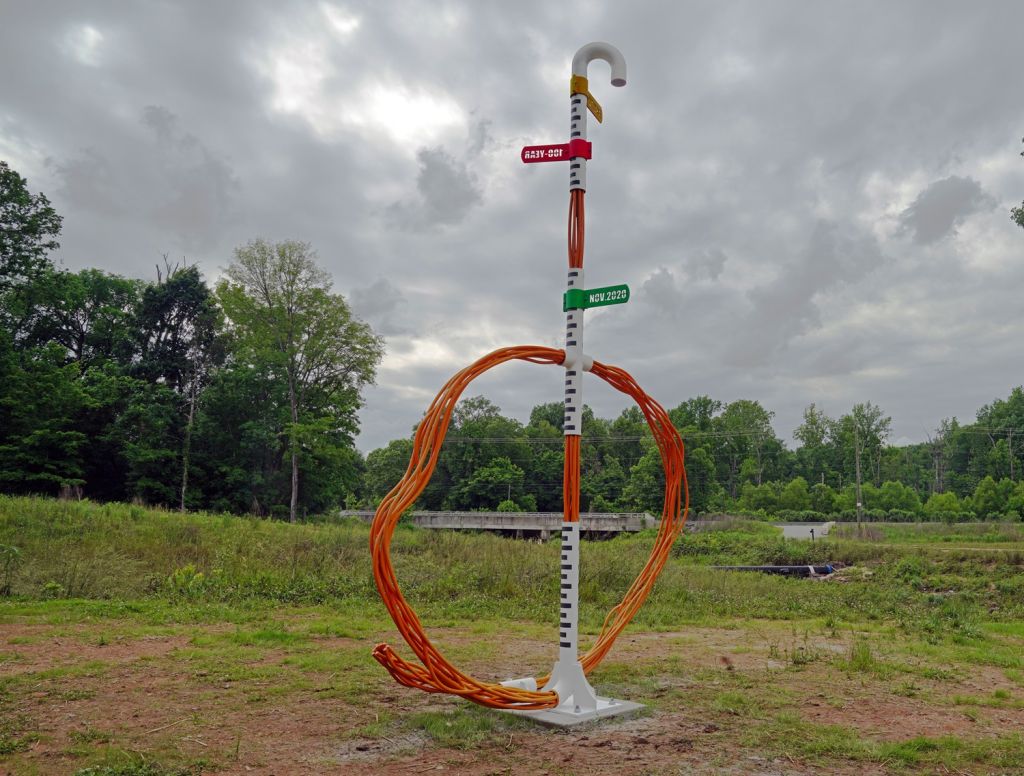Charlotte Sculptor Marries Art and Science in Artwork That Brings Attention to Flood Risks

By Page Leggett
Extreme flooding is now a reality in Charlotte-Mecklenburg due to explosive growth and climate change.
“Mecklenburg County has more than 3,000 miles of streams, creeks and tributaries,” said John Wendel, a meteorologist and senior communication specialist with Charlotte-Mecklenburg Storm Water Services. “Flooding is the number-one natural hazard and the costliest natural hazard in the county. So, it’s important that we educate people about flood risks.”
Storm Water Services embarked on a potentially life-saving public service: To educate residents on the dangerous potential of flooding in certain high-risk areas.
They wanted to grab the attention of folks out enjoying the greenway. Whatever educational tool they chose had to be visually arresting. To elevate an otherwise utilitarian object – a flood marker – to a higher level, they turned to the Arts & Science Council (ASC).
Several years ago, Tim Trautman, Storm Water Services’ engineering and mitigation program manager, attended a conference in a city that had installed flood markers that were more than run-of-the-mill signs. They were artistic. “He came home saying he thought Charlotte needed something similar,” said Wendel. “I said, ‘You know, ASC may be able to help.”
Wendel’s hunch was right. He approached ASC, and as Todd Stewart, ASC’s vice president for public art, recalled, “It was one of those stars-aligning moments.”
An ideal match
ASC convened a five-member artist selection panel to review 12 artists from its Regional Artist Directory, an internal resource of qualified North and South Carolina artists capable of designing and building public art installations with budgets up to $85,000.
The panel was comprised of local artists and curators, community members, and representatives from Storm Water and Mecklenburg County Park and Recreation. The panel helped ASC select four artist finalists, who were invited to submit proposals based on Storm Water Services’ criteria. Each sculpture needed to be a minimum of 8 feet tall and no more than 12 feet tall, durable, able to withstand moving flood water and easily reproducible.
Those proposals were shared with the Storm Water Services team, made up of mostly engineers.
“All the proposals were very good,” Wendel said. “Once we read Marek’s proposal [for ‘Diver, a Flood Marker’] and saw how interested he is in climate change, it really put his over the top.”

For two decades, Marek Ranis’ artistic practice has focused on climate change, flooding and rising sea levels. He was amazed by how closely his interests aligned with project goals.
“Given my long history of engagement in projects that address climate change, I thought this was one of the best public art opportunities I could ever compete for,” he said.
It was also a rare chance for Ranis – a professor of sculpture at UNC Charlotte who’s worked on climate change projects all over the world – to create something local to educate friends, neighbors and colleagues on a challenge we all face.
It’s a challenge we’ve helped create. “Flooding events are caused by a number of factors, but many of them result from human activities,” Ranis wrote in his proposal. “Flood mapping is heavily reliant on historical observations. Thus, it often fails to account for increasing threat [due to] climate change.”
How to breathe underwater
Ranis was awarded the commission, which had a budget of $39,000 to cover design, engineering, testing, fabrication, permitting, installation and the artist’s fee.
“At the time I was thinking about concepts for this project, I was scuba diving off the coast of Southern California working on an art project about giant kelp forests,” Ranis wrote in his proposal.
“Maybe that’s why the motif of a snorkel … came to me,” he said. He chose it as a symbol of risk, survival and adaptation, adding that it felt like the “perfect metaphor.”
The concept delighted Wendel, who said, “His snorkel design has lines like you’d see on a yardstick. He incorporated the measurement part, and he made it fun.”
Making it “fun” wasn’t easy. Climate change is a deadly serious topic.
“I heard an interesting piece on NPR [recently] about a Philadelphia man who died due to flash flooding, brought on by climate change,” he said. “The effects of climate change are going to become a much more significant part of our daily experience, and we need to prepare.”
Stewart appreciated Ranis’ whimsical approach.
“Marek brought a sense of playfulness to the project,” he said. “Some might see that as conflicting when dealing with dangerous flood levels. But it really helps capture the public’s attention and get them to think differently and critically about climate change. There’s some heavy, worrisome information to share, but he’s presented it in a way that’s accessible and inventive.”
The medium is the message

Sometimes, public art is about “art for art’s sake.” But with this job, it was imperative that the message not get lost. Wendel said, “These markers have a purpose: to relay to people the risk of flooding.”
Ranis was equally adamant about getting the message across.
As people walk by the marker, they can see how high the water can get during a 100-year flood, how high it got during the most recent flood (November 2020) and even how high it might be during a future flood. “They can actually get a sense of: Oh my gosh, I’d be underwater right now,” Wendel said.
The message is alarming. But people respond better to humor than they do to scare tactics. And Ranis’ sculpture is large-scale and lighthearted. “‘The Diver’s’ oversized, abstracted human head with a 12-foot snorkel “might feel surreal, almost out of place,” Ranis wrote in his proposal. Rest assured, that was his intent.
It’s so out of place that it demands attention. He also incorporated humor and “a level of absurdity,” saying, “It provides an opportunity for a funny photo but also a moment to pause” and consider the environment and humankind’s role in protecting – or destroying – it.
His sculpture, made of heavy-gauge steel, was also designed to be adjustable. If there’s a new record flood level in the future, Wendel and the team can add the new measurement. Similar markers can also be placed in other locations around the county and adjusted to the flood heights at those spots.
“I’m very grateful to ASC and Storm Water Services for their trust,” he said. “I had no example of anything like this in my portfolio, but they trusted me to pull it off.”
More to come
Ranis marveled over how fast the process went. He presented his final design in February, and the first marker was installed May 17 on flood-prone property owned by Storm Water Services at the confluence of Mallard Creek and Toby Creek near UNC Charlotte.
The finished and installed work exceeded Ranis’ expectations. Even he can’t fully imagine what one of his designs will look like onsite. There’s always an element of surprise.
“When you design in your studio – even using a computer simulation – you don’t know how something will look in a landscape,” he said. “You don’t know about the scale, proportions or how visible it will be.”
The plan is for more markers to be created and installed in flood-prone areas, so Ranis ensured it could be easily reproduced. The next one is expected to be placed along the Chantilly ecological sanctuary on Briar Creek, one of the city’s most flood-prone areas.
Although Ranis has been creating public art for more than 20 years, this was his first public art commission through ASC.
And everyone involved is pleased with the outcome.
“Marek is an extraordinary artist, incredibly passionate about ecology, sustainability, climate change and adaptation to our rapidly changing environment,” Stewart said. “He was the perfect artist for this opportunity, and he’s done exceedingly well with it.”
Storm Water Services wanted to send a message with these flood markers – and it’s the same point Ranis’ art has been making for more than 20 years. “No matter how much we advance our civilization,” he said, “we are still profoundly dependent on and connected with the natural environment.”
Invest in ASC
ASC is committed to equity and believes cultural programs should be accessible to all, build bridges across difference, and reflect our changing community. To achieve this, we invest your dollars in the people, organizations, programs, and ideas that move us toward a more equitable, sustainable, and innovative creative ecosystem. Please complete the giving form below to help us achieve our mission.

